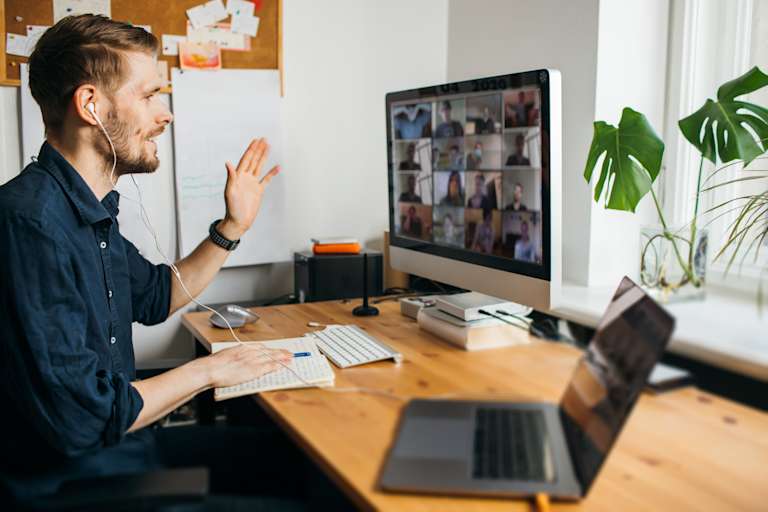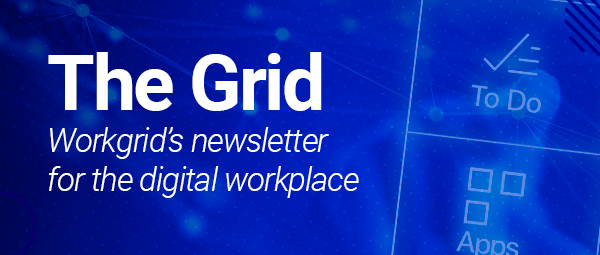Understanding the needs of our digital workplace
If there was one thing we learned at AES throughout the pandemic, it was that we could certainly deliver a functional remote work experience for our people. It was a good realization to have, to know that we could support our workforce and give every person the tools they needed to continue being effective through such a tumultuous time.
![[asset] multiple workplace touch points](https://images.ctfassets.net/z7p73u8c0thn/c6dYX47mXWPbnmetufsCd/05188372c7dc1dbf95978ad92d1346b0/AdobeStock_346644582.jpeg?w=1200&h=800&fl=progressive&q=60&fm=jpg&bg=transparent)
It was important to discover what was most important to our people, to enable an inclusive culture through multiple touchpoints.
Office 365 played a big role in our success with this, addressing many of our technical collaboration and communication challenges by enabling every employee to be connected everywhere, at any time, on any device. That kind of power and flexibility was crucial to supporting our business with everyone working remotely. More importantly, though, it also opened our eyes to the “art of the possible,” prompting us to ask some much-needed questions about our digital workplace.
What else could – or should – we be doing?
Were there greater levels of efficiency and productivity that could be achieved?
What was missing?
Asking these questions wasn’t just an intellectual exercise. It was necessary. We’d come to realize that while everything was going according to plan, our “digital experience” was falling short because it was simply a collection of everything that we’d already been doing. It was “fine.” A success, by most standards, really. We’d gotten through the immediate challenge of enabling a fully remote workforce and things were running smoothly. But we knew that wasn’t going to be enough to get us beyond whatever challenges the pandemic might still present. We wanted more. Better. We wanted to create a purposeful digital experience.
![[asset] workplace-success-stock](https://images.ctfassets.net/z7p73u8c0thn/9EJZAz0Wd75rLMMVbsnyx/0d0e998619892643fabff32e112e894c/workplace-success-stock.png?w=768&h=350&q=60&fm=png&bg=transparent)
Understanding the needs of our people was paramount to digital workplace success.
This drive led us to shift our focus away from the technical and back toward the human element. That had been the missing piece, we realized. Technology was only part of a winning formula. We also needed a true understanding of the needs of people who relied on that technology. And with that in mind, we asked the most important question we could have - “what’s next?”- so we could take what we’d learned throughout the pandemic and improve upon it to deliver the best possible experience for our people.
The path to success: “what’s next?”
It would have been easy to just accept the status quo. Our workforce was working remotely, everyone was communicating and collaborating effectively, and by all accounts, the digital transformation we’d undergone because of the pandemic was a success.
But we knew there was more we could do to address the holistic needs of our workforce and unlock their full potential. And so “what next?” led us to the decision to create a digital people experience. This began with a collaborative exercise that involved working with HR and internal communications leaders to develop a comprehensive set of personas and user journeys, and map out the ideal digital experience for our people.
![[asset] employee-journey-map](https://images.ctfassets.net/z7p73u8c0thn/mMVLVgxZ0Exurj9EfL7EG/0fe60444faf27d6fd09186cf58ce8831/employee-journey-map.png?w=1200&h=662&q=60&fm=png&bg=transparent)
Mapping out the digital journey of our employees was the first step in being able to use technology to effectively address the needs of our workforce. (Source)
Taking everything we learned from that, the next step was to connect the dots between what users needed and what their new experience should look like. How could we put their knowledge and expertise to work while also balancing their productivity and wellness – no easy task given how challenging those things are to achieve in a predominantly remote environment.
It wasn’t until we really understood what our people needed that we were able to shift our focus back to the technical – finding a solution that would enable us to deliver the digital people experience we were looking for.
Technology that meets employees’ needs
After an exploration of a variety of different solutions, we discovered Workgrid, an employee experience platform that enabled us to seamlessly connect our people, information, and systems across the enterprise. The concept of an experience layer was entirely new to us, but it was exactly what we were looking for, a solution that focused on meeting employees’ needs by simplifying their work day.
Workgrid combines the power and functionality of the enterprise applications we’ve invested so much time, money, and training on with the notifications and tasks employees need, delivering it all in a central experience that’s integrated into the flow of work. The platform provides seamless access to the tasks and information employees need the most, giving them more time to focus on meaningful work, increasing productivity and driving engagement improvements.
This is a game changer in terms of the employee journey. It will eliminate the friction people are experiencing from constantly toggling back and forth between all the applications they need to do their jobs. It also gives them a more consumer-like experience, which is what they’ve come to expect from digital experiences based on the technology they encounter in their personal lives.
![[asset] Workgrid Layers](https://images.ctfassets.net/z7p73u8c0thn/5jEJYG1f8luk3tMyElfLwx/4ec2c7b80e08b47297545e1163bf7926/AES_Blog_Layers.jpg?w=1200&h=675&fl=progressive&q=60&fm=jpg&bg=transparent)
Workgrid abstracts just the tasks and information employees need from across the enterprise, delivering it in an easy-to-consume interface that simplifies the work day for employees.
The deceptive simplicity of Workgrid is the ultimate reason for its power.
By creating a command center for just the most important tasks and information employees need, Workgrid helps people better manage their attention and stay focused throughout the day.
![[asset] AES Toolbar](https://images.ctfassets.net/z7p73u8c0thn/1eljGMSP745YuHTfMFE6Pl/7f3a8d82b28dd47727260a1ee4de7ba1/AES_Toolbar.jpg?w=1200&h=821&fl=progressive&q=60&fm=jpg&bg=transparent)
Workgrid is a multi-channel experience, available as a toolbar on an employee portal or intranet, via desktop and mobile apps, and will soon be integrated into MS Teams, giving employees the ultimate flexibility in being able to work wherever it’s convenient for them.
To boost engagement and adoption, and ease any change-management issues people were likely to experience, our pilot program with Workgrid will start with use cases designed to generate excitement with AES People:
Delivering relevant tasks and approvals to AES People where they were already working, to keep things from getting lost in their inbox
Sharing pulse surveys from HR and the communications team to get immediate feedback on how people were doing
Consolidating approvals from systems across the enterprise, such as Ariba, Concur, and Service Now, so people can quickly process high-volume, routine tasks
![[asset] Intranet To Knows and To Dos Workgrid Example](https://images.ctfassets.net/z7p73u8c0thn/7Kq2fmsFU2bDJBKBH1Tjz5/8b5ab3179b2ed46272aa9ff0b283245e/AES_Toknows_ToDos.jpg?w=1200&h=821&fl=progressive&q=60&fm=jpg&bg=transparent)
We’re currently in the pre-pilot phase of our Workgrid launch. Based on what we learn from that experience, we’ll tweak things as necessary and roll out to a targeted pilot group in Brazil. We’ll also prepare to expand to additional use cases, with integrations to ADP for providing employees easy access to their payslip data, Workday Learning for notifications about mandatory training and celebratory notifications and Power BI to push relevant dashboards to people.
Workgrid will also be integrating with Teams in the coming months, which is an advancement we’re very excited about. AES lives and breathes in Teams, relying on it heavily for collaboration. Being able to access the power of Workgrid from within the collaboration platform we all spend so much time in will give us the omnichannel experience we’re looking for.
The ongoing journey - always learning
If there’s one thing this journey has taught us, it’s that we must always be learning. In fact, we’re already reevaluating our personas and use cases to make sure that we’re poised to meet the ever-changing needs of our people. We’ve accepted this is a process that will be ongoing, because improving the digital employee experience isn’t an end-game, it’s a journey. To do it right, you have to keep asking “what’s next?”
If you’d like to learn more about our digital transformation journey, check out the webinar I did for the Digital Workplace Group Technology Exchange, “The Digital Workplace of the Future: Focused on People, Unifying Technology.” It explains how Workgrid’s integration with Teams will work, plus the question-and-answer session at the end is particularly helpful in providing details on how we’re striving to provide the best possible digital employee experience for our people.

![[quote] evolution of the digital workplace](https://images.ctfassets.net/z7p73u8c0thn/2vD6ZuJT12wekderFVEyu5/db50e905ead5399a46b3137c2fb1ecc1/AES_FollowUp_Quote.png?w=780&h=200&q=60&fm=png&bg=transparent)



